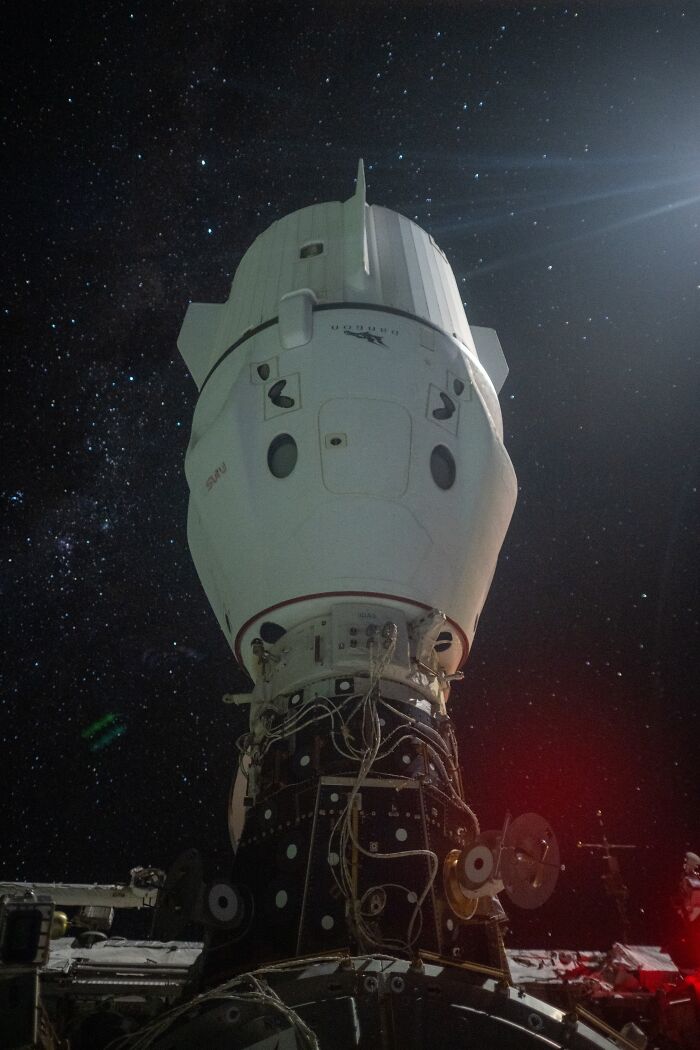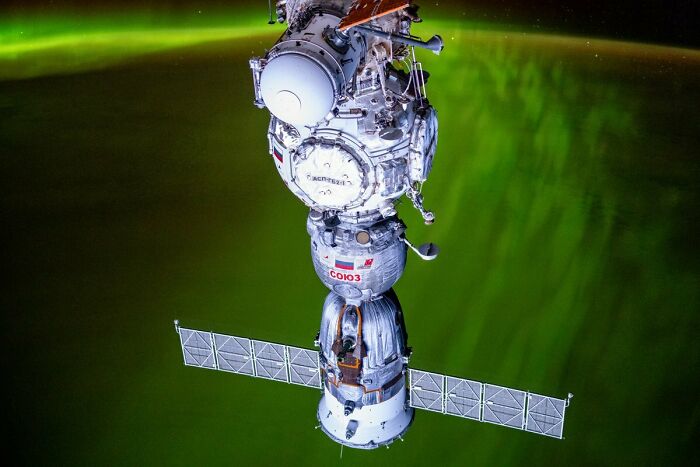It just so happened that NASA astronaut Matthew Dominick was not only lucky enough to be in space during the peak of auroral activity, but also had a chance to capture it in a time lapse. More info: Matthew Dominick
Matthew Dominick and the Expedition 71 crew made an incredibly beautiful time lapse of the moon setting into streams of colorful aurora 250 miles (400 kilometers) above Earth
Share icon Image credits: Matthew Dominick Share icon Image credits: The International Space Station Share icon Image credits: Matthew Dominick Every stargazer could tell that the view from Earth looking up at the starry sky is an incredible one, but only few are able capture this breathtaking scenery on camera from space. NASA’s astronaut Matthew Dominick and the Expedition 71 crew just received a cargo shipment which included some new camera lenses and were in the right place at the right time to witness the moon setting into streams of red and green aurora, followed by a sunrise lighting up Soyuz with a light blue. “It’s just an incredible view out the window. And I realize that so many people are fascinated by the pictures that we get to take up here,” Dominick shared his excitement. “The moon makes it way towards the horizon to set amongst red and green aurora. Felt so lucky to grab this shot,” he wrote in another post on his X account. The astronaut has been aboard ISS since March as a commander of the SpaceX Crew-8 mission. During his visit, Dominick managed to capture images of spectacular auroral lights with a backdrop of spacecraft like Boeing’s Starliner, SpaceX Crew Dragon or Russia’s Soyuz. “Recent solar activity pushed the aurora closer to us. The Soyuz hangs from the station in a stream of aurora,” Dominick wrote at the time on social media. “Soyuz is illuminated in a light blue from a sun behind the camera and in front of the space station that is just about to rise,” was added next to the remarkable photo he shared. Share icon Image credits: Matthew Dominick While taking incredible images of Earth, the atmosphere and the stars from so high above can seem truly amazing, it’s also definitely a very challenging task. Since photography is a significant part of NASA astronauts’ life on board the ISS, they are trained in the use of a camera at Johnson Space Center in Houston. The ISS is traveling at a speed of about 17,500 mph (28,000 kph), which means that a timed exposure will blur the features of Earth. Also, it’s difficult to keep the stars as pinpoints in exposures greater than a quarter, or maybe half, a second. “This is just because of the pitch rate of the station, and it makes the stars trail instead of appearing as points. You just can’t do a long time exposure,” explained another NASA astronaut, Don Pettit. Yet no matter all the challenges, the final results are making it all worth it, since photos always bring so much happiness not only to the astronauts, but also to all the humans on Earth. “One of the pure joys I get out of doing astrophotography from the space station is the ability to share, through imagery, what we as astronauts get to see,” Pettit shared. “It’s not exactly the same, though, as the color, the dynamics, cannot be recorded yet with still imagery to the same level as what you see with your eyeballs.”
It was perfect timing to try out a new lens that recently arrived on Cygnus
Share icon Image credits: Matthew Dominick Share icon Image credits: NASA Share icon Image credits: NASA For more than 20 years, humans have worked and lived aboard the International Space Station and have witnessed the most incredible spectacles of our universe. Thanks to the new technologies, not all of us have to go to space to get an enchanting glimpse into our planet from high above. All these photos taken by Dominick are not only beautiful but also very precious ones, since the ISS is settled to retirement by splintering into a thousand pieces before crashing into the Pacific Ocean somewhere around 2030.
People on the internet were amazed by new photos from the ISS
Share icon Image credits: John Kraus Share icon Image credits: NASAEarth Share icon Image credits: johnchamilton Share icon Image credits: MikeBrettSmith Share icon Image credits: Tristannatorr Share icon Image credits: GregDieselPhoto Share icon Image credits: radioheadfloyd Share icon Image credits: HeadofDoge Share icon Image credits: JoyMWilliams Share icon Image credits: Brongis9163 Share icon Image credits: sohamsuke Share icon Image credits: sani_emilio Share icon Image credits: MrDrD34TH Anyone can write on Bored Panda. Start writing! Follow Bored Panda on Google News! Follow us on Flipboard.com/@boredpanda!





















